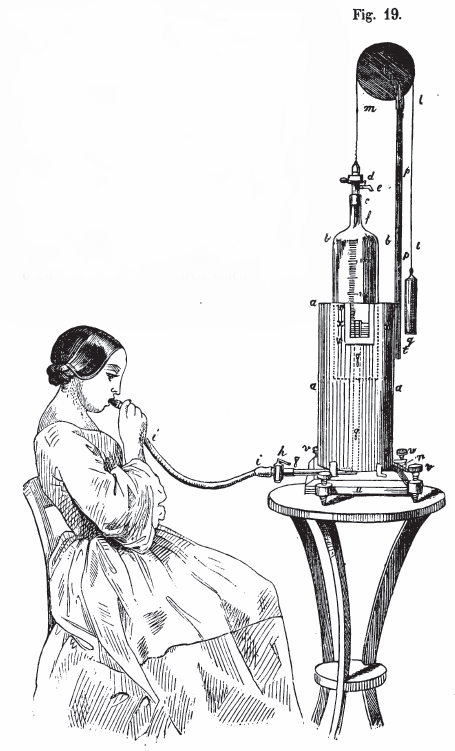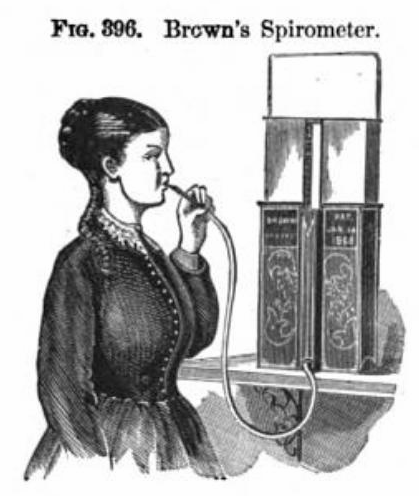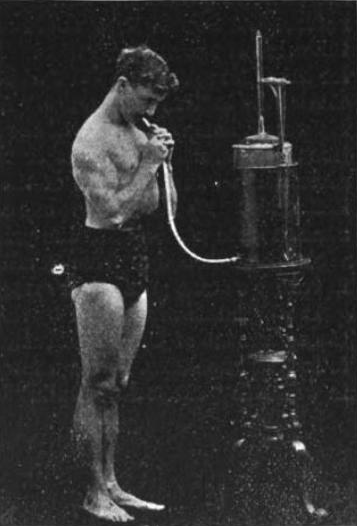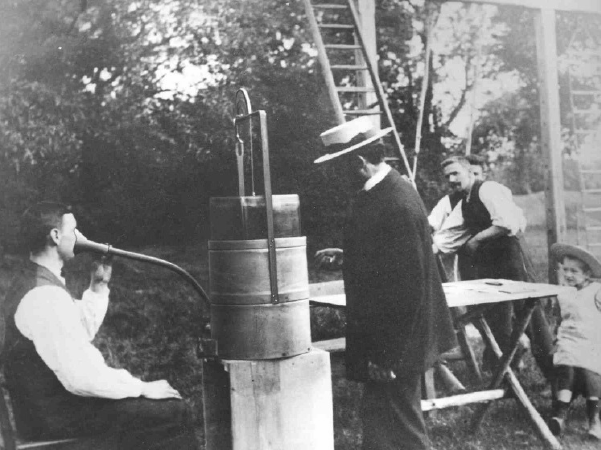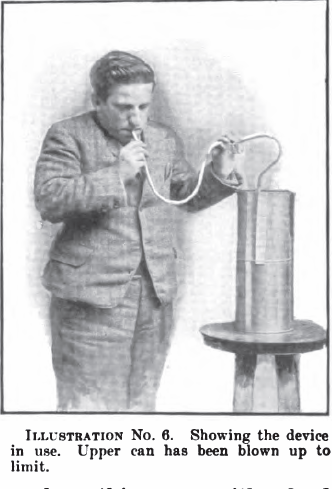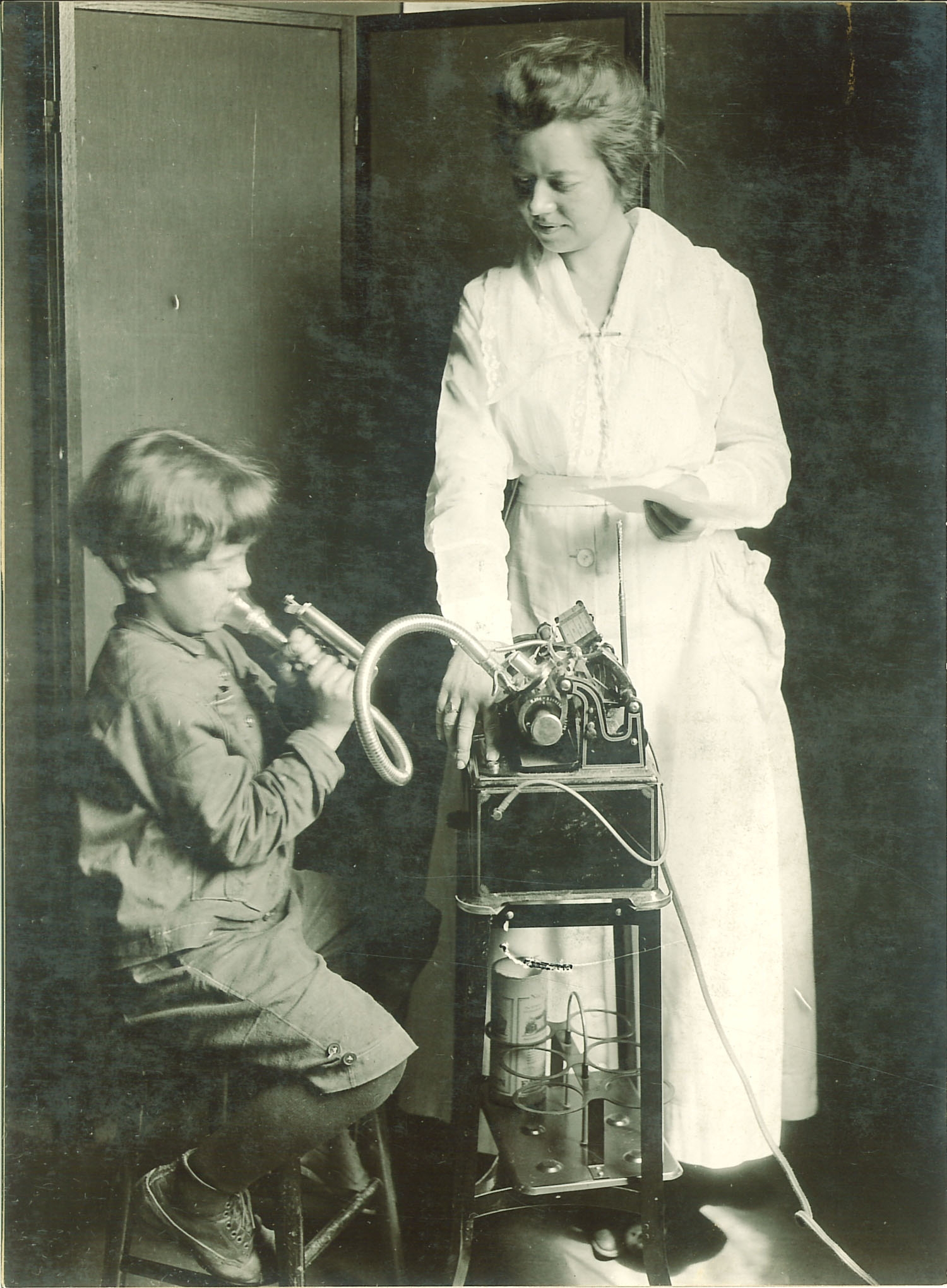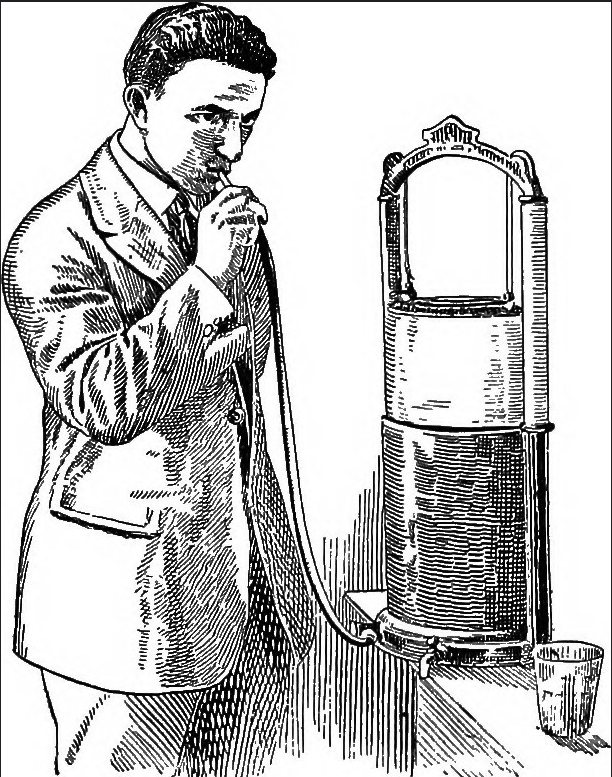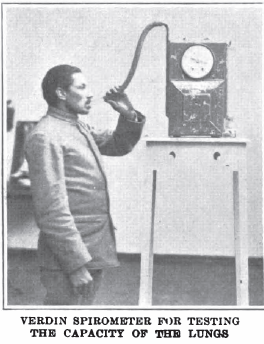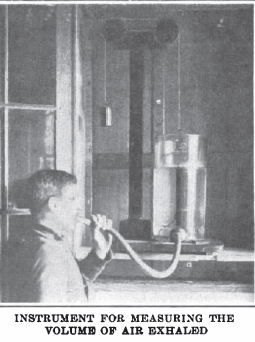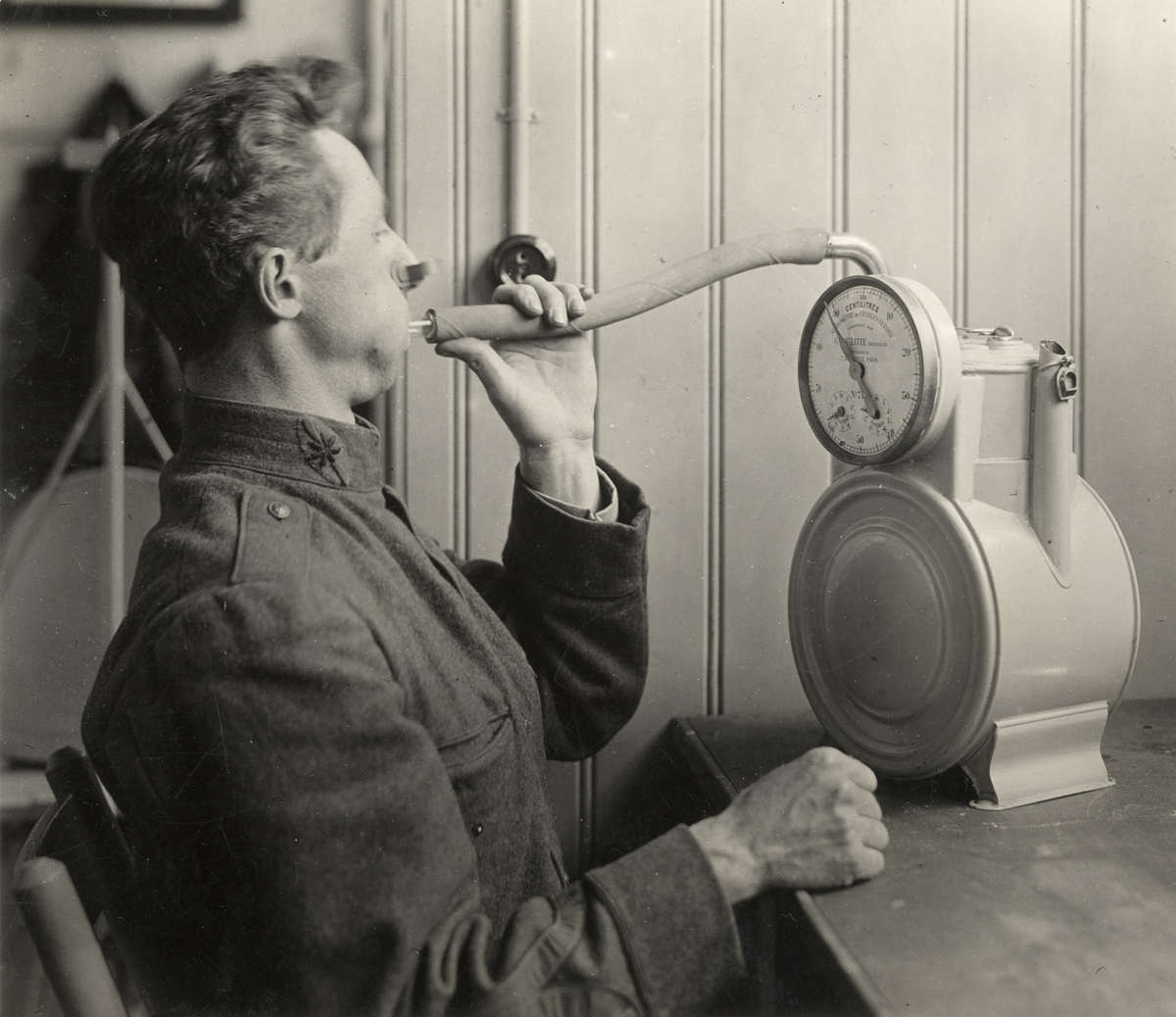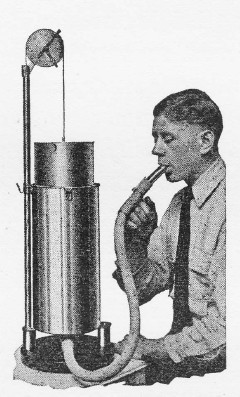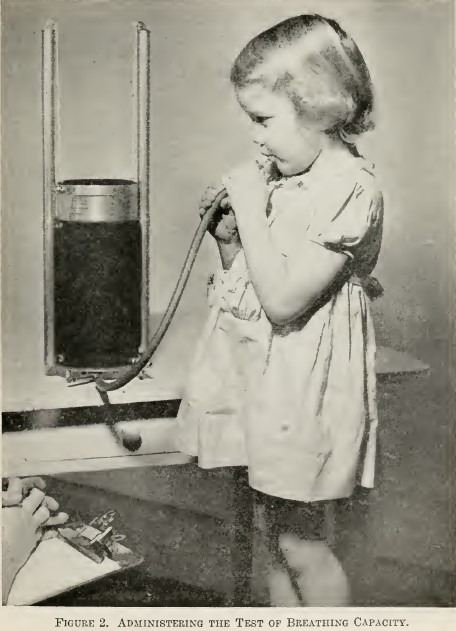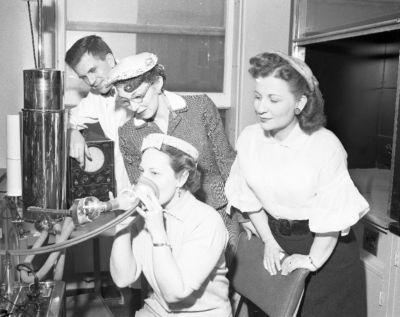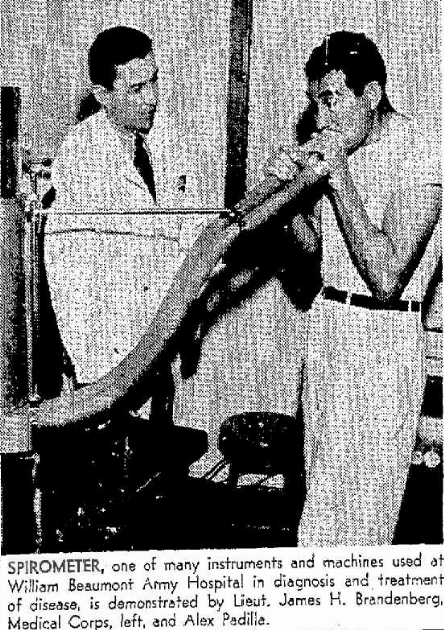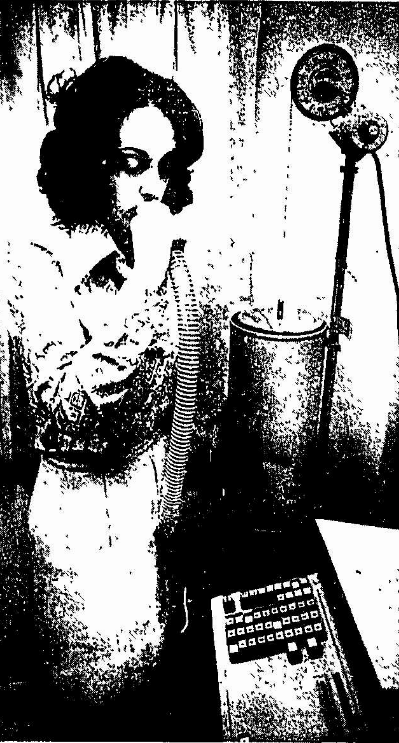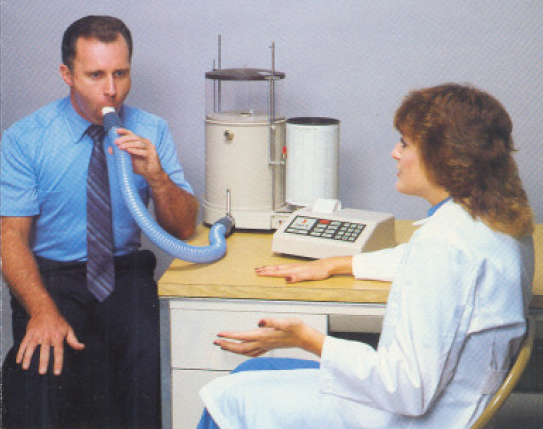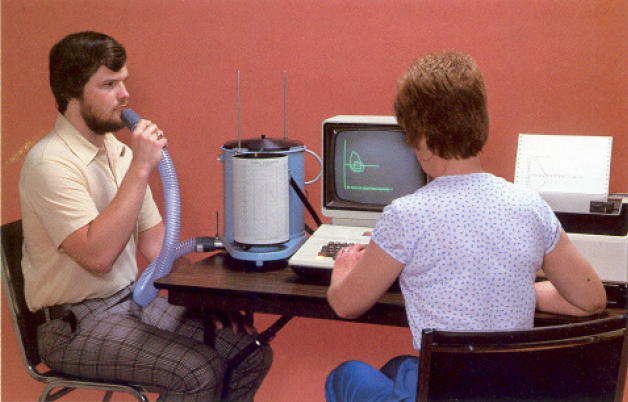The way in which a spirometry test is performed has changed over the years. Up until 1950 the interest was only in the Vital Capacity so the speed the test was performed did not matter. After 1950 the FEV1 and FEV1/FVC ratio came into existence and speed mattered.
Spirometry, 1850. From: Die Erkenntniß der Krankheiten der Brustorgane aus physikalischen Zeiche n oder Auscultation, Percussion und Spirometrie: Nach Heribert Davie’s Vorlesungen u. eigenen Beobachtungen by Johann Friedrich Hermann Albers, 1850. Endplate.
Spirometry, 1854. From Handbuch der speciellen Pathologie und Therapie, , Volume 1; Volume 5. Wintrich MA, Virchow R, Von Bamberger H. 1854.
Spirometry, 1879. Part of an advertisement for Brown’s Spirometer. A non-counterweighted, water-seal spirometer with a rectangular bell. From: George Tiemann and Co. Catalog, The American Armamentarium Chirurgicum, 1879, page 98.
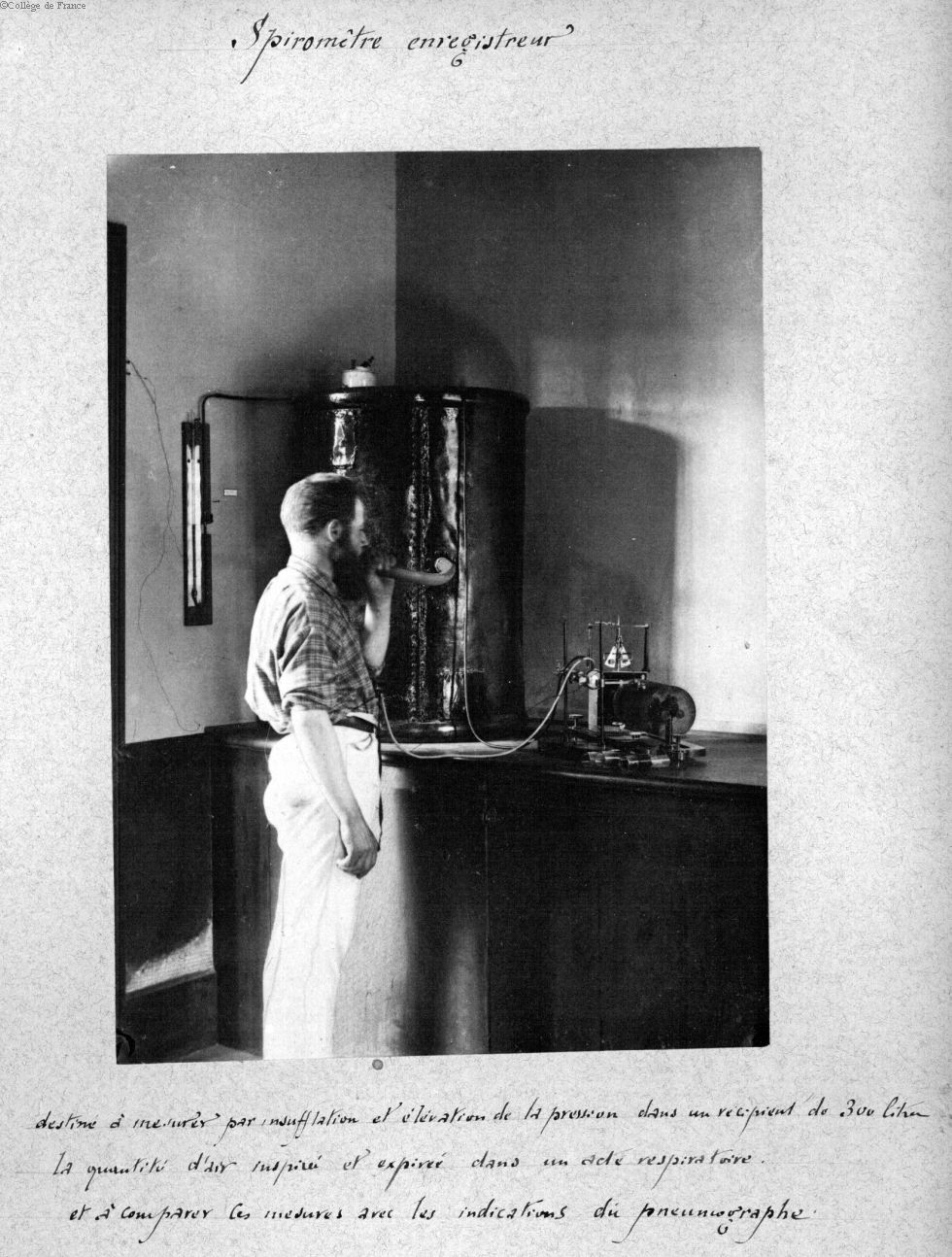
Spirometry, 1886. Spirometer logger for measuring insufflation and increased pressure in a 300 liter container the amount of air inspired and expired in a respiratory act and compare the measurements with the indications of pneumographe. Attributed to Etienne-Jules Marey / 1882-86 / Station / physiological / I / Methods and Techniques. Found on the Medic Database.
Spirometry, 1892. From: Manual for Physical Measurements in Connection with the Association Gymnasium Records, by Luther Halsey Gulick, published by the International committee of Young men’s Christian associations, 1892, page 39.
“After inflating the lungs to their utmost capacity, blow slowly into the spirometer. Three trials may be allowed. Record the greatest one.”
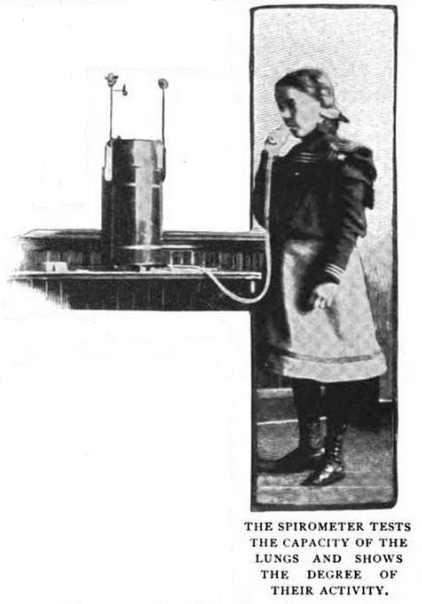
Spirometry, 1901. From “Scientific Child Study”, by Edward Marshall, The American Magazine, 1901, Volume 51, No. 5, Page 427.
Spirometry, 1904. The Drager brothers. Bernhard Drager (center). Johann Heinrich Drager (right). From: http://www.students.informatik.uni-luebeck.de/zhb/ediss502.pdf
Spirometry, 1904. From: Building of Vital Power: Deep Breathing and a Complete System for Strengthening the Heart, Lungs, Stomach and All the Great Vital Organs by By Bernarr Macfadden, 1904, page 155.
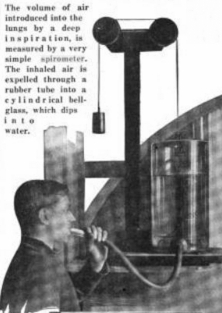
Spirometry, 1915. From “The scientist and the athlete. The physiological laboratory of the French military school at Joinville” by Jacques Boyer, Scientific American, May 8, 1915, page 293.
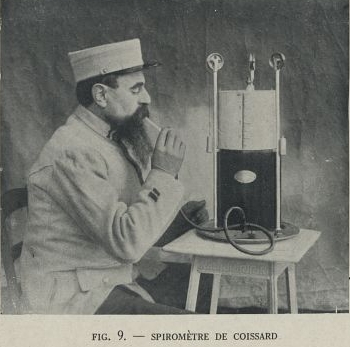
Spirometry, 1918. From “Science and dedication: the Health Service, the Red Cross, war Solidarity works and postwar – published with the collab. Messrs. J. Abadie, Dr Jacques Bertillon, Dr Georges Brouardel, Published in Paris byA. Quillet in 1918. Found on the Medic Database (item med45_85x0278).
Spirometry, 1919. From “How to make your own lung tester”, Popular Science, May 1919, page 113.
Spirometry, 1920. Although labeled as spirometry, the “spirometer” is an Edison Dictograph. From: University of Iowa Digital Library.
Spirometry, 1920. Found on Flickr. Image from page 130 of “The principles of health control” (1920). Fig. 28. — The Spirometer. An instrument for measuring the capacity of the lungs.
“Respiratory tests – to measure breathing capacity. Fill the lungs completely full of air, and then force as much of it as possible into a spirometer (Fig. 28) noting the number of cubic inches registered. To avoid the danger of germ transmission, the mouth-piece should be dipped each time into some disinfecting solution, such as a four per cent solution of carbolic acid in water, and then wiped dry with a towel. Instead of the solution, individual wooden mouthpieces, obtained at slight expense from supply houses, maybe used.”
Spirometry, 1921. From: The assessment of physical fitness by correlation of vital capacity and and certain measurements of the body. By Georges Dreyer and George Fulford Hanson, 1921, page 9.
“The subject should be seated on a high stool with his back straight, opposite the spirometer, the dial being so placed that he cannot see the readings. This is done for the purpose of keeping him in ignorance of the readings while be examined, as it is found that any such knowledge tends to interfere with the accuracy of the results. The neck, chest and abdomen must be free from any obstruction to free movement, such as collar belt or stays. The subject is asked to fill the lungs to the maximum capacity, then the nose is held with one hand, the mouthpiece is placed well inside the lips with the other hand in such a manner as to prevent any escape of air round it. He now blows steadily into the tube, and empties the lungs as completely as possible into the spirometer, being encouraged during the last period of expiration to make the utmost effort to expel all air from the lungs. The readings are given in liters and decimals of liters, to be read directly from the dial. After each expiration the needle on the single liter dial should be brought back to zero by the observer. At the end of a long series of expirations the spirometer should be inverted, to allow any condensed moisture to escape. Five successive observations should be taken and recorded, the subject being allowed a short time for a short rest after each.”
Spirometry, 1921. From: The cult of the sound body. Apparatus employed in modern physiological laboratories to test physical development. By T.V. Davidson. Scientific American Monthly. Jan 1921, page 34.
Spirometry, 1921. From: The cult of the sound body. Apparatus employed in modern physiological laboratories to test physical development. By T.V. Davidson. Scientific American Monthly. Jan 1921, page 34.
“To discover the amount of air taken into the lungs during a deep inspiration, a very simple spirometer is used at Joinville. It consists of a bell glass balanced by a counter-weight and immersed in a cylinder three quarters full of water. The subject exhales the air through a rubber tube with a glass mouthpiece, which runs to the lower tubulur of the spirometric vessel. The section of this tube is exactly equal to that of the trachea so that there will be no resistance to the air proceeding from the lungs of the subject and no alteration of the respiratory rhythm. The air exhaled causes the internal pressure to be increased and the amount of the increase is shown on a manometer. Furthermore, if care is taken to graduate the manometer beforehand by injecting exactly 1, 2, 3, 4, 5, etc, liters of air and marking the corresponding level of water for each, the volume of air injected can be read off at once.”
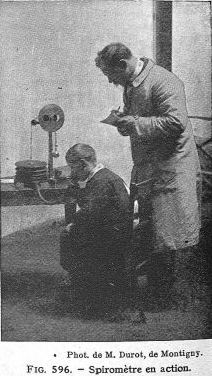
Spirometry, 1924, with a Galante Spirometer. From Illustrated Medical Larousse Encyclopedia, published in Paris by Larousse, 1924, page 334. Found on the Medic Database.
Spirometry, 1925. Found at a website that best translates as Netherland Memories.
“Luchtvaartschool. Op het vliegveld Soesterberg wordt in 1925 een begin gemaakt met de opleiding en het testen van aspirant vliegeniers/piloten. Foto: Een leerling piloot blaast uit door een glazen mondstuk van een spirometer. Op deze manier wordt de longcapaciteit gemeten.”
Translated: “Luchtvaartschool. A start on the Soesterberg Airport in 1925 made the training and testing aspiring aviators / pilots. Photo: A pupil pilot blows out through a glass nozzle of a spirometer , The lung capacity in this way were measured.”
Spirometry, 1925. Using a Sanborn spirometer. From Vital Capacity of the Lungs by J.A. Myers, published 1925 by Williams and Wilkins, page 92.
Spirometry, 1940. From: Breathing capacity and grip strength of preschool children, by Eleanor Metheny, University of Iowas Studies, Studies in Child Welfare Volume 18, No. 390, 1940, page 26.
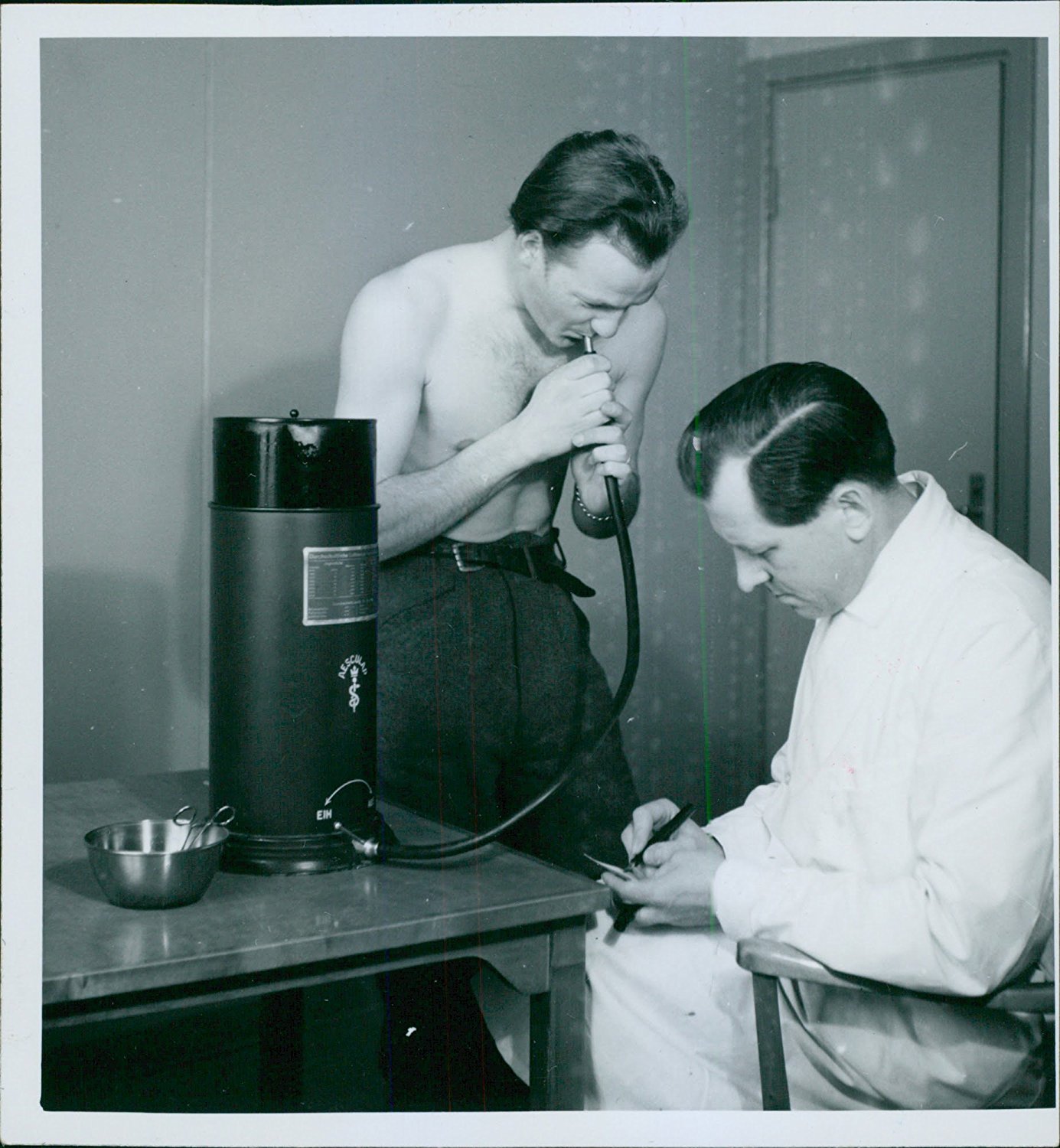
Spirometry, 1949. Found on Pinterest. Labeled elsewhere as “Vintage photo of Dr. Sixten Haroldson measures lung volume of a draftee”. Dated as 4/5/1949. Likely taken in Sweden. Spirometer is an Aesculap model that only measured vital capacity.
Spirometry, 1954. A publicity photo shoot with a pneumotachometer at the University of Illinois (?). Individuals and source are unknown.
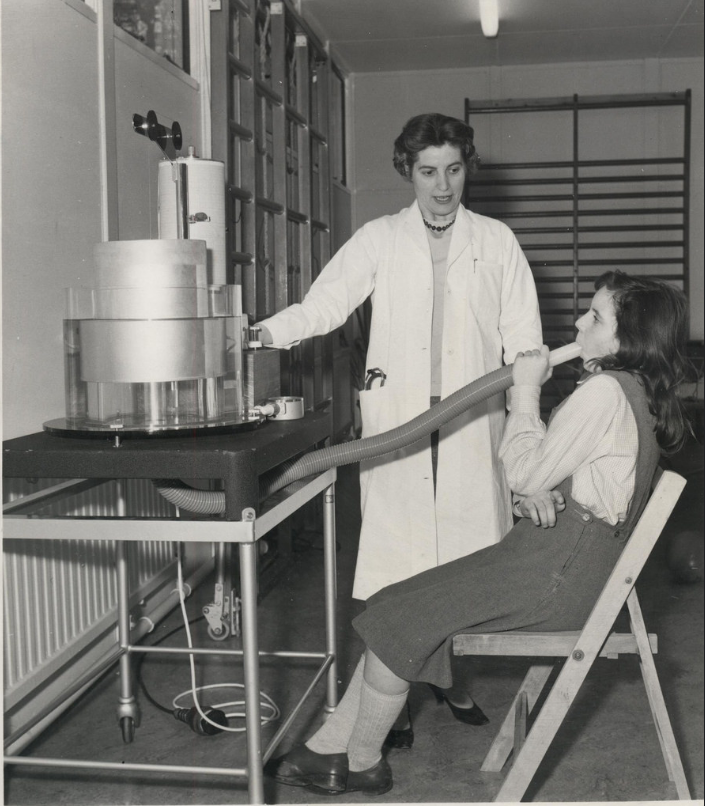
Spirometry, circa 1955. Undated photo found on Flickr. Uploaded by the Cystic Fibrosis Trust. At a guess it comes from the mid-1950’s. Spirometer, location and the people in the photo were unidentified.
Spirometry, 1957. From the El Paso Herald-Post, El Paso, Texas, Aug 31, 1957, Section B, page 14.
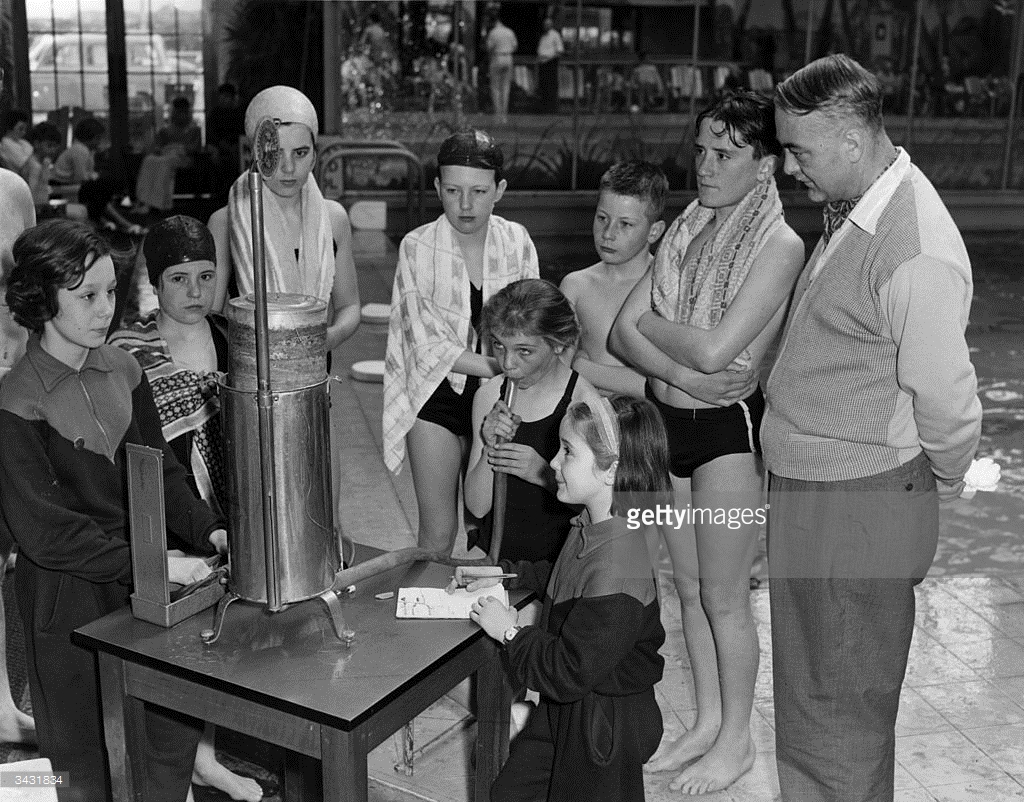
Spirometry, 1960. Found on Getty Images. Captioned as “Twelve year old Susan Cox blowing into a spirometer which will measure any increase in lung capacity after a training session in the pool at the Queen’s Highcliff Hotel.” Photo credited to Harry Todd. Spirometer manufacturer was not named but it could be a Sanborn or Collins spirometer.
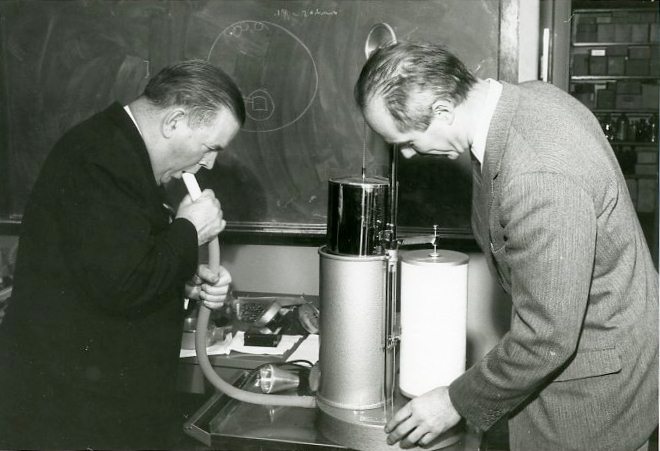
Spirometry, 1961. Found on the Francis A. Countway Library of Medicine website. The Honorable James A. Burke (left) and Dr. Benjamin Terres (right) measure respiration using a spirometer on Congressional Day in 1961 at the Harvard School of Public Health. Spirometer is likely a Collins 9L respirometer.
Spirometry, 1965. From: Thousand Aviator Study: Methodology. Oberman A, Mitchell RE, Graybiel A. U.S. Naval School of Aviation Medicine. 1965
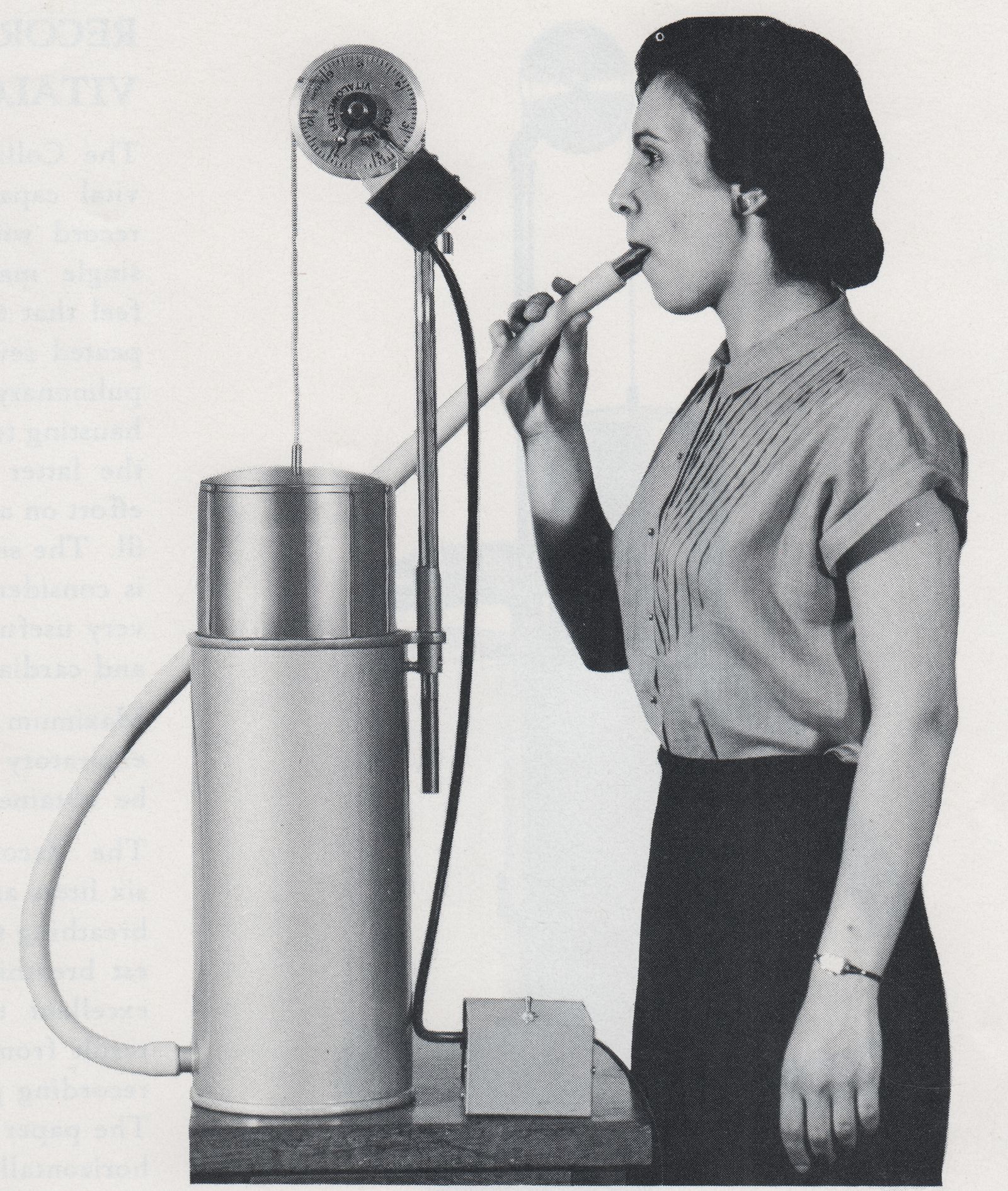
Spirometry with a Collins Timed Vitalometer, 1966. From ‘A Catalog of Pulmonary Function Equipment and Accessories’, W. E. Collins Inc., page 11.
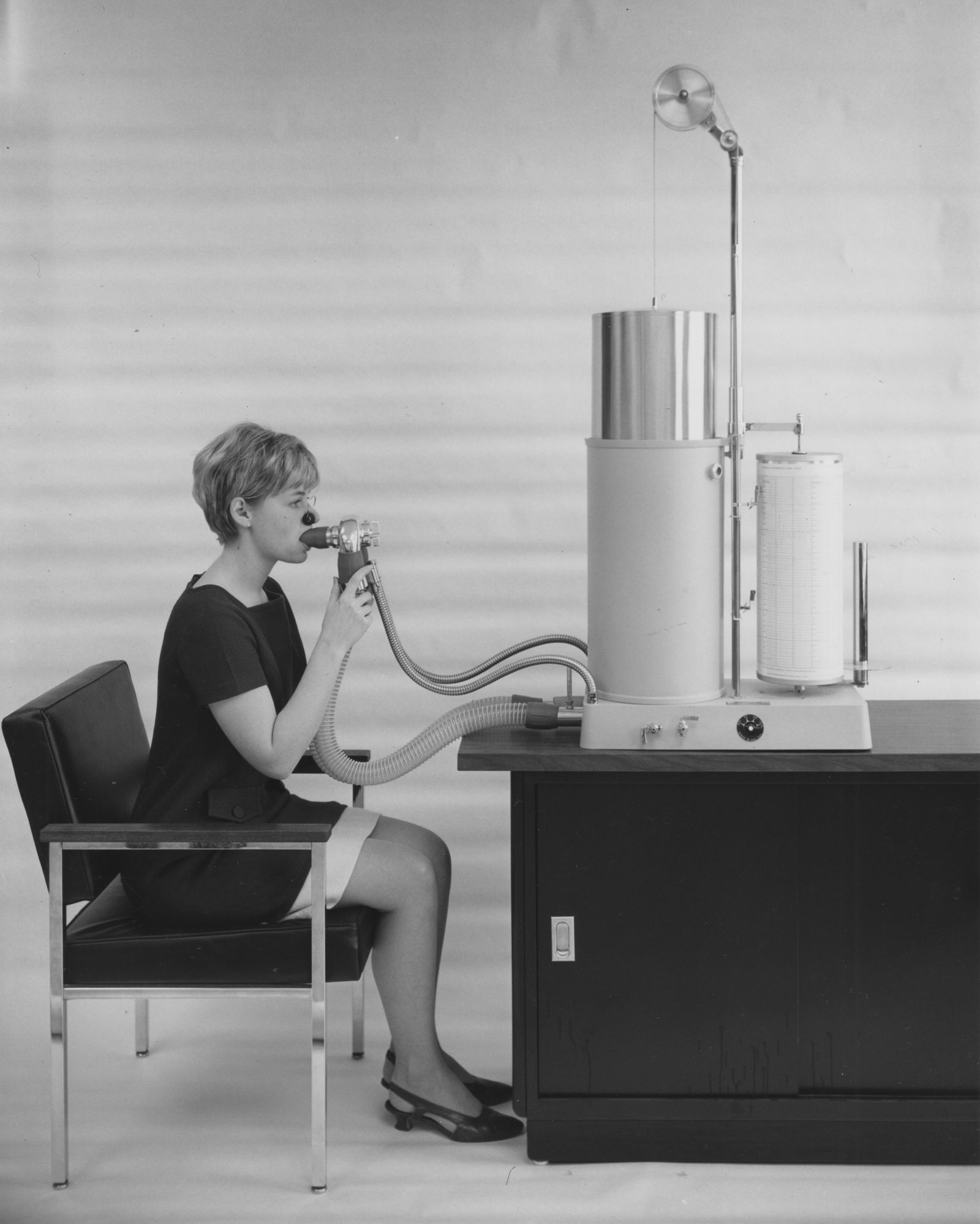
Spirometry with a Collins 13.5 Liter Respirometer, 1968. From a publicity photo dated March 6, 1968.
 Spirometry 1969. From the Spokane Daily Chronicle, November 11, 1969, page 3.
Spirometry 1969. From the Spokane Daily Chronicle, November 11, 1969, page 3.
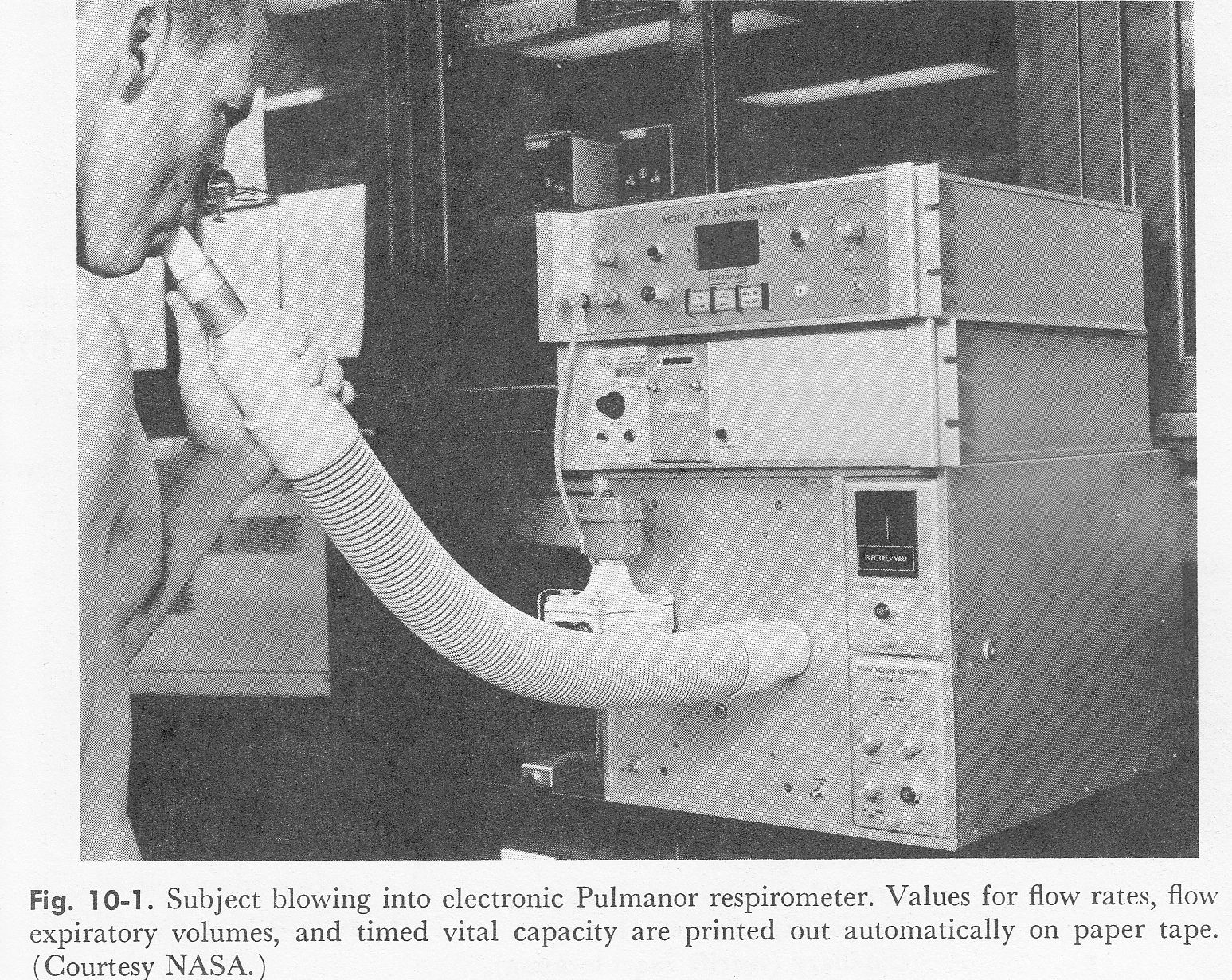
Spirometry, 1972. From “Laboratory manual for physiology of exercise”, by Laurence E. Morehouse, Published by C.V. Mosby, 1972, page 85. From “Laboratory manual for physiology of exercise”, by Laurence E. Morehours, Published by C.V. Mosby, 1972, page 85.
Spirometry 1975: From The Herald, Arlington Heights, Illinois, March 19, 1975. Front page section 4.
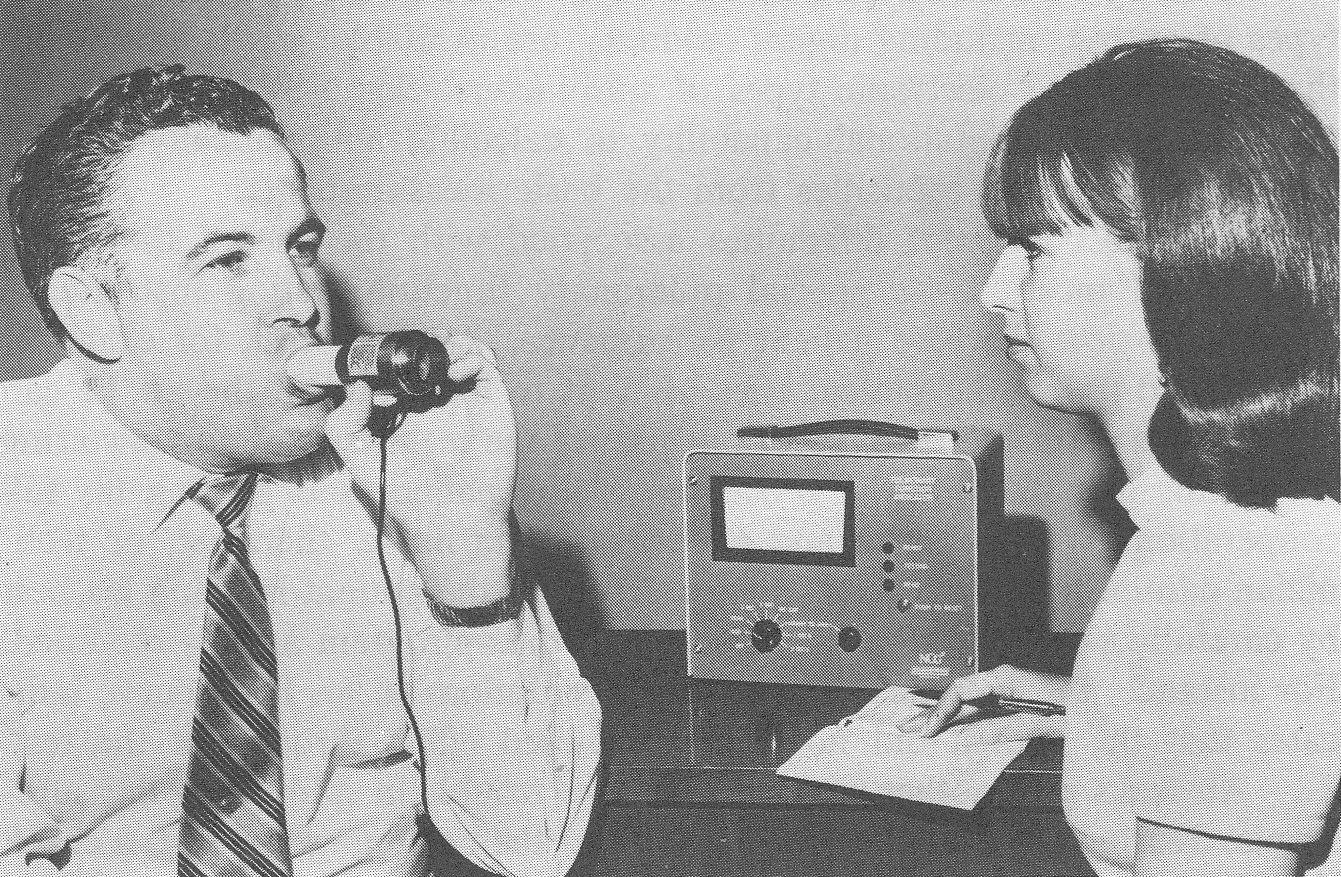
Spirometry, National Cylinder Gas Pulmonary Function Indicator, 1976. From Medical Instrumentation for Healthcare, by Cromwell L, Arditti M, Weibell FJ, Pfeiffer EA, Steele B, Labok J. Published by Prentice-Hall, 1976. Page 264.
Spirometry, Collins Eagle II, 1984: Photo is from a sales brochure courtesy of James Sullivan, BA, RPFT, Supervisor, Pulmonary Laboratories, Memorial Sloan Kettering Cancer Center.
Spirometry, Collins S-520, 1984. Used a Stead-Wells spirometer and Included an Apple II computer with 48K RAM, dual floppy disk drives and a monochrome monitor. Photo is from a sales brochure courtesy of James Sullivan, BA, RPFT, Supervisor, Pulmonary Laboratories, Memorial Sloan Kettering Cancer Center

PFT History by Richard Johnston is licensed under a Creative Commons Attribution-NonCommercial 4.0 International License.

